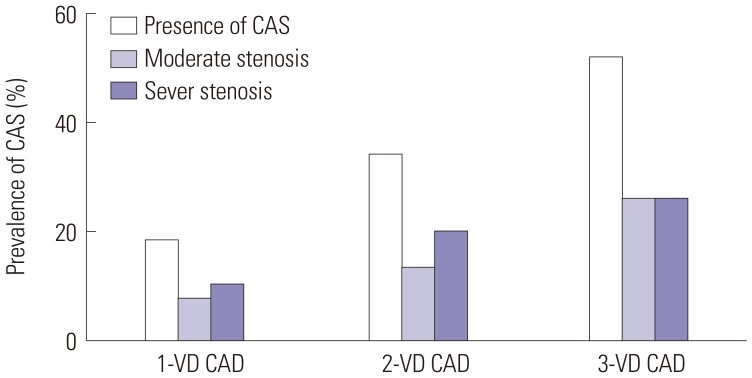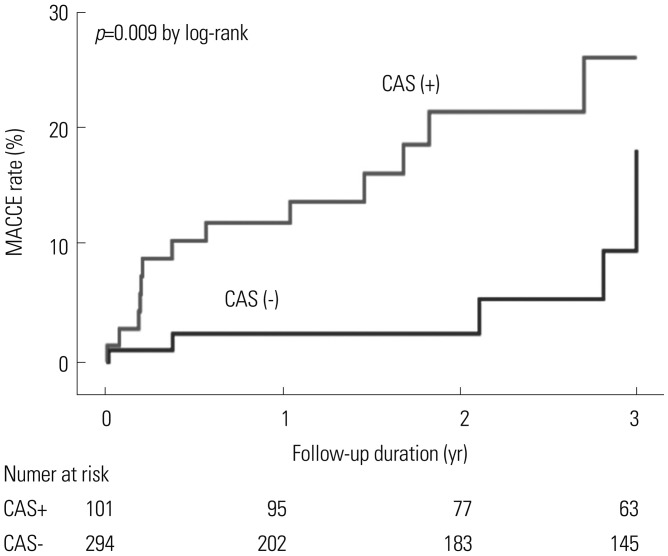Yonsei Med J.
2019 Jun;60(6):542-546. 10.3349/ymj.2019.60.6.542.
Prevalence and Clinical Outcomes of Asymptomatic Carotid Artery Stenosis in Patients Undergoing Concurrent Coronary and Carotid Angiography
- Affiliations
-
- 1Division of Cardiology, Department of Internal Medicine, Sanggye Paik Hospital, Inje University College of Medicine, Seoul, Korea. byungokim@paik.ac.kr
- KMID: 2446959
- DOI: http://doi.org/10.3349/ymj.2019.60.6.542
Abstract
- PURPOSE
The prevalence and clinical outcomes of asymptomatic carotid artery stenosis (CAS) in patients with coronary artery disease (CAD) have not been thoroughly studied. We examined the prevalence and predictors of asymptomatic CAS detected by carotid angiography and determined the impact of concomitant CAS on prognosis in patients undergoing coronary angiography (CAG) due to CAD.
MATERIALS AND METHODS
Between January 2013 and July 2015, 395 patients who underwent carotid digital subtraction angiography to screen for CAS during CAG were analyzed. The presence of CAS was defined as angiographically significant stenosis (≥50%). Major adverse cardiac and cerebrovascular event (MACCE) rates were compared between patients with and without CAS. MACCEs included a composite of cardiac death, cerebrovascular death, acute myocardial infarction, and stroke.
RESULTS
Of the 395 patients, 101 (25.5%) patients had significant CAS. The independent predictors of CAS were age, male sex, hypertension, diabetes, and multi-vessel disease. In patients with CAD, the presence of CAS was as an independent predictor for MACCEs after adjusting for confounding factors (hazard ratio 2.47, 95% confidence interval 1.16-5.24, p=0.018).
CONCLUSION
Asymptomatic CAS was documented in up to 25% of patients with CAD. The presence of CAS in patients with CAD was associated with a higher rate of MACCEs. Therefore, detection of CAS by carotid angiography during CAG may be important for risk stratification for CAD patients, particularly those with multi-vessel disease.
Keyword
MeSH Terms
Figure
Cited by 1 articles
-
Feasibility and Applicability of Wireless Handheld Ultrasound Measurement of Carotid Intima-Media Thickness in Patients with Cardiac Symptoms
Albert Youngwoo Jang, Jeongwon Ryu, Pyung Chun Oh, Jeonggeun Moon, Wook-Jin Chung
Yonsei Med J. 2020;61(2):129-136. doi: 10.3349/ymj.2020.61.2.129.
Reference
-
1. Yamagishi M, Terashima M, Awano K, Kijima M, Nakatani S, Daikoku S, et al. Morphology of vulnerable coronary plaque: insights from follow-up of patients examined by intravascular ultrasound before an acute coronary syndrome. J Am Coll Cardiol. 2000; 35:106–111. PMID: 10636267.
Article2. Cohen GI, Aboufakher R, Bess R, Frank J, Othman M, Doan D, et al. Relationship between carotid disease on ultrasound and coronary disease on CT angiography. JACC Cardiovasc Imaging. 2013; 6:1160–1167. PMID: 24229768.3. Akosah KO, McHugh VL, Barnhart SI, Schaper AM, Mathiason MA, Perlock PA, et al. Carotid ultrasound for risk clarification in young to middle-aged adults undergoing elective coronary angiography. Am J Hypertens. 2006; 19:1256–1261. PMID: 17161771.
Article4. Grotta JC. Clinical practice. Carotid stenosis. N Engl J Med. 2013; 369:1143–1150. PMID: 24047063.5. North American Symptomatic Carotid Endarterectomy Trial Collaborators. Barnett HJM, Taylor DW, Haynes RB, Sackett DL, Peerless SJ, Ferguson GG, et al. Beneficial effect of carotid endarterectomy in symptomatic patients with high-grade carotid stenosis. N Engl J Med. 1991; 325:445–453. PMID: 1852179.
Article6. Tanimoto S, Ikari Y, Tanabe K, Yachi S, Nakajima H, Nakayama T, et al. Prevalence of carotid artery stenosis in patients with coronary artery disease in Japanese population. Stroke. 2005; 36:2094–2098. PMID: 16179563.
Article7. Jeevarethinam A, Venuraju S, Dumo A, Ruano S, Rosenthal M, Nair D, et al. Usefulness of carotid plaques as predictors of obstructive coronary artery disease and cardiovascular events in asymptomatic individuals with diabetes mellitus. Am J Cardiol. 2018; 121:910–916. PMID: 29499924.
Article8. Cappelletti A, Astore D, Godino C, Bellini B, Magni V, Mazzavillani M, et al. Relationship between Syntax Score and prognostic localization of coronary artery lesions with conventional risk factors, plasma profile markers, and carotid atherosclerosis (CAPP Study 2). Int J Cardiol. 2018; 257:306–311. PMID: 29506713.
Article9. Anzidei M, Napoli A, Zaccagna F, Di Paolo P, Saba L, Cavallo Marincola B, et al. Diagnostic accuracy of colour Doppler ultrasonography, CT angiography and blood-pool-enhanced MR angiography in assessing carotid stenosis: a comparative study with DSA in 170 patients. Radiol Med. 2012; 117:54–71. PMID: 21424318.
Article10. Nederkoorn PJ, van der Graaf Y, Hunink MG. Duplex ultrasound and magnetic resonance angiography compared with digital subtraction angiography in carotid artery stenosis: a systematic review. Stroke. 2003; 34:1324–1332.
- Full Text Links
- Actions
-
Cited
- CITED
-
- Close
- Share
- Similar articles
-
- Frequency of Combined Atherosclerotic Disease of the Coronary, Periphery, and Carotid Arteries Found by Angiography
- Carotid ultrasound in patients with coronary artery disease
- Carotid Artery Stenting for Asymptomatic Carotid Stenosis: What We Need to Know for Treatment Decision
- Carotid Artery Stenting
- Relationship Between Carotid and Coronary Atherosclerosis in the Elderly



